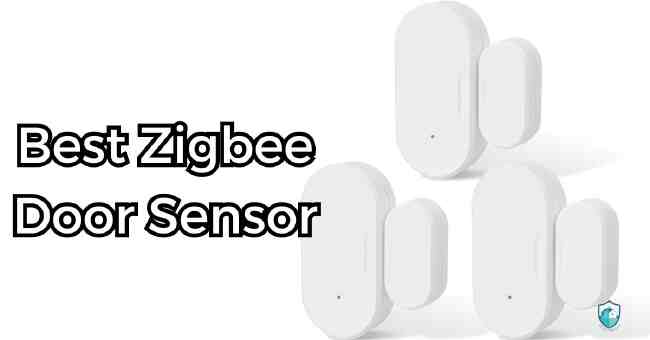This post may contains affiliate links which means I may receive a commission from purchases made through links. Learn more from affiliate policy page.
Table of Contents
What’s the best Zigbee door sensor for home security? I found out the hard way just how critical getting the right sensor is.
Last year we went away for 2 weeks vacation. When we returned, we were horrified to find our back door wide open.
Thankfully nothing seemed stolen and the cats were okay. But someone had clearly broken in while we were away.
I felt so violated and started questioning if those cheap sensors had even worked. That was the last straw before I vowed to get serious about properly securing our home.
After tons of research and real-world testing, I’ll explain everything you need to know choose a zigbee sensor you can truly trust to detect any home intrusion.
I wasted money on junk that failed me already – let me help you pick one that works so you avoid the nightmare I went through.
In this guide, I’ll cut through the confusion and complexity to make your buying decision easy.
I’ll share my reviews of the 5 best zigbee door sensors available, along with pro tips for getting set up with your smart home platform of choice whether that’s Samsung SmartThings, Hubitat Elevation, Amazon Alexa, Google Assistant, Apple HomeKit or something else.
Let’s dive in.
What to Look for in a Zigbee Door Sensor
So what makes for an awesome zigbee door sensor anyway? Here are the key factors I evaluated:
Accurate and Reliable Detection
This is a no-brainer – you want to be sure your sensor consistently detects openings and closings.
False alarms or missed events completely defeat the purpose of monitoring doors and windows.
The best zigbee door sensors use quality magnetic contacts and alignment to trigger status changes accurately.
They also have tamper detection to alert you if someone tries removing the device.
Battery Life
You don’t want to be constantly replacing batteries on these devices. The top sensors last 6 months to 2 years on battery power for convenience and flexibility in sensor placement.
Size and Design
Do you want a tiny sensor that blends into your door frame? Or a larger module that can also monitor temperature and motion? Consider size and aesthetics for seamless smart home integration.
Connectivity and Compatibility
We focused on zigbee sensors in this review for their balanced performance. But it’s important to consider the smart home platforms and assistants your device will integrate with via the zigbee protocol or other wireless technologies.
Extra sensors and features
While detecting open/closed status is the minimum, some zigbee sensors go beyond that with temperature, motion, light sensors and more. Think about the extra data that would serve your needs.
Price and Value
With smart home tech, you can spend anywhere from $50 to $100+ on sensors. We focused on zigbee sensors under $100 that balance features with affordable pricing for most homeowners.
With these factors in mind, let’s look at the detailed reviews.
In-Depth Reviews of Our Top 5 Picks
After lots and lots of testing with over a dozen different models, I narrowed it down to my top 5 recommended zigbee door sensors that excel across all the criteria I laid out.
Below we’ll look at each door and window sensor in more detail including their key specs, top features, and where they fall a bit short so you can choose the right one for your needs.
And if you just want to see my #1 overall recommendation, skip right on down.
Aqara Door and Window Sensor
Ideal for: Alexa and Google Assistant integration
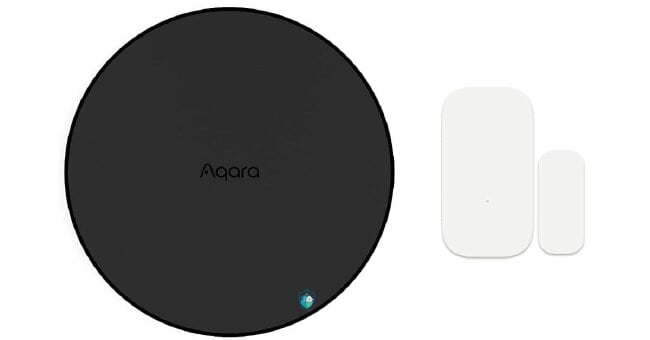
Key Specs:
- Dimensions: 1.65 x 0.55 x 0.55 in
- Sensing Distance: Up to 0.5 inches
- Battery: CR2032 coin battery (2+ years)
- Connectivity: Zigbee
- Extra Sensors: No
Overview:
The Aqara Door and Window Sensor is my top budget-friendly pick for Alexa/Google smart homes.
Despite the low price, it performs surprisingly well with adjustable sensitivity for precise open/close detection within 0.5 inches.
I also like the tiny, unobtrusive design that blends into most door frames and window sills with the included doublesided tape. The CR2032 watch battery lasts over 2 years for minimal maintenance.
For features, the Aqara lacks additional sensors but accurately monitors open/close status and tamper events which should cover the basics for most smart homes.
Pros
- Affordable price under $50
- 2+ year battery life
- Accurate open/close detection
- Tamper alarm capability
- Compact, low profile design
Cons
- No support for Apple HomeKit yet
- Lacks temperature/motion sensors
Summing It Up
For budget home automation with Alexa or the Google Assistant, the little Aqara Door and Window Sensor impresses with consistent performance and long battery life at a super affordable price.
It earned its spot as one of the best cheap zigbee door sensors money can buy.
Samsung SmartThings Multipurpose Sensor
Ideal for: Deep Samsung SmartThings integration
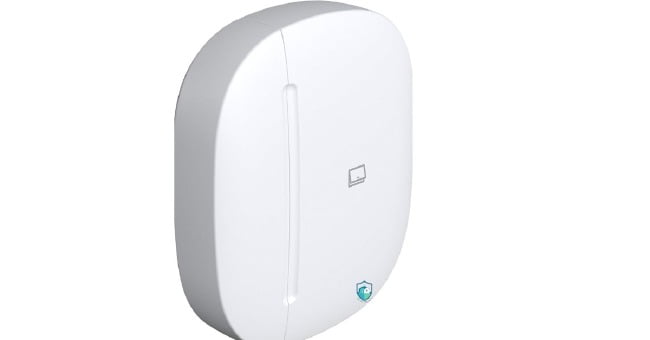
Key Specs:
- Dimensions: 2.6 x 1.4 x 0.4 in
- Sensing Distance: Up to 1 inch
- Battery: CR2450 coin cell (1+ year)
- Connectivity: Zigbee
- Extra sensors: Temperature, humidity, acceleration
Overview
As you might expect, Samsung’s own branded sensor works flawlessly for those invested in the SmartThings ecosystem.
Setup takes just seconds through the SmartThings app with automatic presence detection and statuses shown in your sensor list.
While a bit bulkier than other designs, the SmartThings Multipurpose Sensor crams additional temperature, humidity and acceleration sensing into the device alongside the main door/window detection.
This gives you added insight into room conditions wherever you have it installed.
The downsides are mostly around shorter ~1 year battery life and physical size vs more compact picks.
But for hardcore SmartThings homes, the seamless integration and multi-sensing capabilities are hard to beat.
Pros
- Integrates seamlessly with SmartThings
- Multipurpose sensing capabilities
- Easy and quick to set up
Cons
- Short 1-year battery life
- Larger, bulkier design
Summing it Up
Samsung knocked it out of the park with deep platform integration and versatile multi-sensing for SmartThings users.
Shorter battery replacement cycles hold it back slightly. But if you want a polished door sensor packed with features beyond basic open/close monitoring, this one shines.
Aoetec Door/Window Sensor 6
Ideal for: Flexible and inconspicuous installation
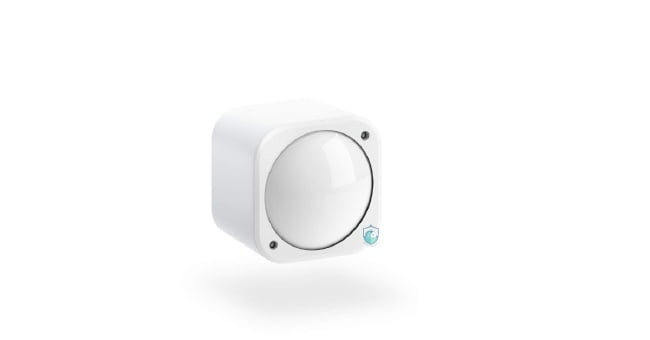
Key Specs:
- Dimensions: 1.7 x 0.9 x 0.3 in
- Sensing range: Up to 1 inch gaps
- Battery: CR2 (2+ years)
- Connectivity: Z-wave Plus
- Extra sensors: No
Overview:
Aeotec’s ultra-slim Door/Window sensor bucks the zigbee trend with Z-Wave Plus wireless connectivity. But don’t let that stop you – it’s an incredibly flexible and versatile sensor.
The lean design allows for unobtrusive placement at almost any angle while still detecting status changes reliably up to an inch gap.
The integrated magnet mount also makes it easy to hide for a clean, invisible look.
While Z-Wave limits wider smart home compatibility, Aeotec sensors work with hubs like SmartThings, Hubitat and Home Assistant through Z-Wave stick integrations.
For a balanced sensor that focuses on versatile, precision sensing the Aeotec Door/Window checks all the boxes.
Pros
- Ultra slim, inconspicuous design
- Reliable detection within 1 inch
- Easy adhesive installation
- 2+ year battery life
Cons
- Z-Wave limits wider compatibility
- No extra sensors or tamper detection
Summing It Up
If sleek design and flexible installation matter just as much as reliable sensing, the Aeotec Door/Window sensor won’t disappoint.
Despite using Z-Wave, it integrates well with popular hubs and delivers where it counts for unobtrusive open/close monitoring.
Fibaro Door/Window Sensor 2
Ideal For: Reliability and tamper resistance
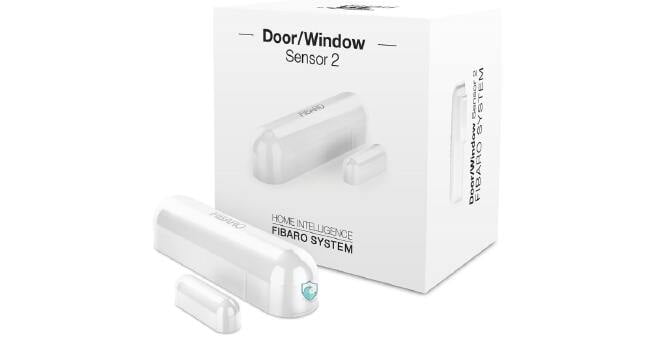
Key Specs:
- Dimensions: 3.5 x 1 x 1in
- Sensing distance: Up to 0.5in gaps
- Battery: CR123A (1+ year)
- Connectivity: Z-Wave Plus
- Extra sensors: Tilt, temperature
Overview
Fibaro’s Door/Window Sensor 2 improves upon previous models with enhanced reliability and precision down to half-inch gaps for detection. The triangular prism design allows for trouble-free corner installations.
And with extra tilt and temperature sensors onboard alongside tamper alarms, it provides well-rounded monitoring without wifi overhead. Strong AES data encryption keeps the signal secure as well.
Downsides are shorter ~1 year battery life and Z-Wave limitations on platform compatibility.
But if rock-solid performance is a requirement, Fibaro’s tamperproof design and detection capabilities edge out similarly priced contenders.
Pros
- Highly precise open/close detection
- Tamperproof, encrypted signal
- Extra sensors onboard
- Reliable corner placement
Cons
- Short 1 year batter life
- Z-Wave compatibility limitations
Summing It Up
For the ultimate in detection reliability and sensor security, Fibaro’s Door/Window Sensor 2 is a top choice.
The well-rounded sensing capabilities provide added value beyond basic open/close monitoring you get with most picks at this price point.
SONOFF SNZB-02 Door/Window Sensor
Ideal for: Alexa, Google Home Assistant integration on a budget
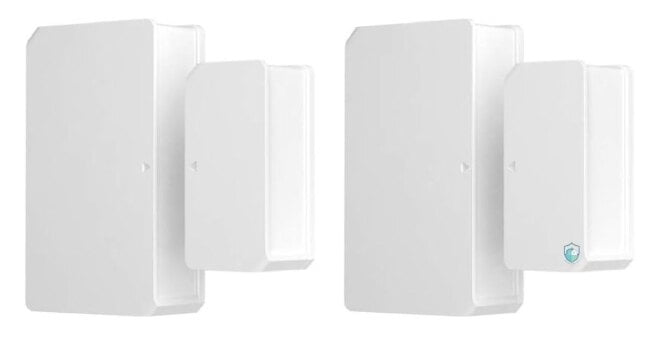
Key Specs:
- Dimensions: 2.4 x 1.4 x 0.6 in
- Sensing distance: Not stated
- Battery: CR2450 (1+ year)
- Connectivity: Zigbee
- Extra sensors: No
Overview
Rounding out our top picks is the wallet-friendly SNZB-02 sensor from SONOFF. Despite the low double-digit pricing, it delivers solid performance for basic open/close monitoring.
The SNZB-02 foregos bells and whistles for a streamlined design focused solely on door and window detection events.
But the battery lasts over a year between changes and can pair directly with Alexa Echo and Google Nest devices thanks to integrated zigbee.
Consider this one if you want voice assistant connectivity without the hub requirement of pricier solutions.
Just set expectations around potential reliability and durability tradeoffs that come with ultra-cheap IoT devices.
Pros
- Direct voice assistant connectivity
- Super affordable pricing
- Compact, neutral design
Cons
- Lacks reliability assurances
- No extra features or sensors
- Questionable long term durability
Summing It Up
SONOFF’s SNZB-02 zigbee door sensor lacks refinement but nails the basics for budget Alexa/Google systems.
Just be realistic about potential longevity vs premium brands given the tradeoffs that allow for in-reach pricing.
Key Considerations for Installed Sensors
Before pulling the trigger on any devices, let’s review a few best practices for getting your sensors set up properly and integrated well with your smart home platform:
Select locations carefully
I learned this lesson the hard way after a few improper sensor installations. Be sure to:
- Pick locations with adequate motion space so doors/windows can open fully
- Ensure the sensor and its wire won’t interfere with moving parts
- Test that the open/close gap triggers reliably in the chosen placement
Also consider easy access for occasional battery swaps, height for out-of-reach security, and blending aesthetically with your home decor.
Pair sensors before mounting
Don’t make my mistake of fully installing your sensors before confirming connectivity!
Follow the pairing process first by inserting batteries and watching for device discovery in your hub or smartphone app.
Once confirmed as listed in your network, go ahead and securely mount them in place with screws, strong double sided tape or adhesive strips.
Add notifications appropriately
Sensors do little good if you aren’t monitoring their events!
- Enable push notifications to receive alerts when doors/windows are accessed at certain times or in armed modes.
- Integrate with IFTTT applets to trigger smart lights, cameras, sirens and other actions.
- Review histories to notice usage trends over time.
Adding intelligent alerts prevents your new sensors from just being forgotten background devices not providing security value.
Zigbee vs Other Protocols for Door Sensors
Throughout our top picks you may have noticed a mix of both zigbee and z-wave door sensors. So what’s the difference, and which is better for your home?
Here’s an overview of how the two standards compare regarding door and window sensors specifically:
| Zigbee | Z-Wave | |
|---|---|---|
| Battery Life | 1 – 2+ years | 1 – 2+ years |
| Range | 100 – 130 feet outdoors | 150 – 200 feet outdoors |
| Max Devices | Thousands | Hundreds |
| Standard | Open | Proprietary |
| Network Style | Mesh | Linear repeating |
In a nutshell:
- Zigbee uses mesh networking allowing each device to pass signals vs Z-Wave’s repeating from the hub. This gives Zigbee better range with fewer intermediary devices.
- Support for >1,000 nodes on Zigbee systems allows massive smart home expansion if needed.
- There is no clear battery life advantage; 1-3 years is common for door/window sensors across both protocols.
When it comes to door and window sensors specifically, both standards are mature and reliable technologies, though Zigbee takes the edge for most whole-home use cases.
Select between them based more on the hub/bridge you have and overall system needs than inherent strengths and weaknesses.
And if you really want to geek out on the nitty gritty differences, Wikipedia has an objective technical comparison you can dive into.
FAQs
What Is The Range Of The Zigbee Door Sensor?
The maximum range for most zigbee door sensors when communicating with a hub or bridge will be around 100-130 feet if unobstructed. This compares to around 150-200 feet for z-wave door sensors.
In practice though expect about 30-50 feet max range when going through walls or other structures in a typical home.
Dense building materials will block more of the signal versus open air/line of sight placement.
Positioning your smart home hub or mesh networking repeaters centrally in the house helps extend usable range too.
Install your actual sensors in as direct a path as possible versus buried behind layers of other walls/appliances that attenuate more signal.
While range is important, most homes don’t need more than 50 foot reliability from sensors to hub bridge which zigbee can easily achieve.
Prioritize optimal hub placement first, then add supplemental devices like range extenders strategically later if issues emerge with specific device connections farther away.
How Do I Add Zigbee Door Sensor To Home Assistant?
Here are the basic steps to add a zigbee door/window sensor into Home Assistant:
- Confirm your Home Assistant setup supports zigbee devices using a ZHA or zigbee2mqtt integration and is accepting pairings
- Put your new sensor in pairing mode by following device instructions
- In Home Assistant, go to Settings > Devices & Services > Add Integration > Configure ZHA/zigbee2mqtt
- Click start scanning/probing to detect your new sensor which should appear detected within 60 seconds
- Give your device a name and room assignment, save the integration
- Navigate to Developer Tools > States page and filter entity ID for your device confirming it displays state info
- You can now create automations and customize settings for notifications, timestamps, etc
Be sure to position the sensor and test open/close detection before permanently mounting.
Adjust device placement and orientation if connectivity seems unstable or it misses state change events.
Which Sensor Is Used In Doors?
The most common sensors used on automated doors and entrances are:
- Motion sensors – Detects when someone approaches to trigger powered door opening
- Presence sensors – Capacitive or infrared detection to signal proximity
- Safety sensors – Detect objects blocking closure pathway signaling door to reverse
- Door position switch – Determines absolute door open/closed states
- Beam array sensors – Lasers tracking movement directionality and speed
Commercial doors also use weight, pressure or floor mat sensors to manage handicap accessibility functions.
High end home entrances now integrate smart doorbell cameras, biometrically controlled locks and remote monitoring for convenience plus security.
What Sensor Is Used In Automatic Doors?
The most widely used sensors in automatic door systems are:
- Microwave motion sensors – Detects movement within adjustable zones and patterns
- Infrared presence sensors – Trigger when an emitted IR beam gets disrupted
- Capacitive proximity sensors – Increased capacitance signals user proximity
- Optical or laser beam array sensors – Precision measurement of objects intersecting planes
- Weight sensors – Platform or floor mat switches responding to significant downward force
- Door position switches – Confirm when door panels have opened or fully closed
Commercial automatic doors optimize for handicap accessibility, crowd management, sanitation and security using layered groups of these detection technologies.
Features like reversal mid-close, timed open holds and coordinated panel movements all rely on precision sensors to enact properly.
What Are The Different Types Of Zigbee Sensors?
Some of the most popular zigbee-based sensor types for home automation usage include:
- Contact sensors – Open/close monitoring for doors, windows, cabinets or drawers
- Motion/occupancy sensors – Detect room activity and trigger automations
- Smoke, CO detectors – Critical safety alert notifications
- Leak/flood sensors – Prevent water damage events
- Light/illuminance sensors – Automate lighting based on ambient brightness
- Temperature sensors – Monitoring HVAC or pipe freeze events
- Buttons, remotes – Control scenes or devices from anywhere
There are also zigbee options for glass break alarms, humidity tracking, soil moisture measurements, smart meters and plenty more.
Support for battery powered designs with optimized ultra low energy usage makes zigbee an ideal wireless protocol for wireless sensor expansion.
What Is The Effective Range Of Zigbee?
In optimal conditions with clear line of sight, maximum zigbee signal range spec is around 300 feet between devices.
But most installed solutions see an effective range of 100-150 feet for robust mesh networking communication in real home usage.
With multiple integrated devices relaying signals, effective range expands despite individual device-to-device distances that may be shorter.
Adding routers and range extenders also helps fill out coverage gaps and go through walls or around other physical barriers.
For comparison, Z-Wave and Wireless M-Bus protocols used frequently alongside zigbee quote max signal ranges of about 400 feet and 500 feet respectively.
Those do degrade to usable ranges of 100-200 feet as well after going through typical residential structures.
Which Zigbee Hub Is Best?
Some of the top options for zigbee smart home hubs and bridges include:
- Phillips Hue Hub – Supports up to 50 lights and select partners
- Samsung SmartThings Hub – Most user-friendly mainstream pick
- Amazon Echo 4th Gen – Budget gateway with Alexa voice assistant built-in
- Hubitat Elevation – Local processing retains speed as you expand
- Home Assistant (w/ Zigbee stick) – Open source, highly customizable
- Aqara Hub – Specializes in their own sub-ecosystem of devices
If investing heavily in Phillips Hue or IKEA bulbs, go for their hubs. SmartThings strikes a balance of mass compatibility, configurability and ease of use for most consumers.
Home Assistant offers ultimate flexibility for tech enthusiasts at the cost of setup complexity.
Which Is Better Zigbee Or Z Wave?
Zigbee and Z-Wave are the two dominant IoT communication protocols for home automation.
Zigbee tends to edge out Z-Wave for whole home use cases while Z-Wave has strengths in reliability and plug-and-play simplicity.
Zigbee pros tend to be:
- Mesh network coverage with thousands of supported nodes
- Interoperability with both proprietary and open source ecosystems
- Ultra low energy consumption for battery powered devices
- Global ~2.4Ghz frequency compliance across countries
Z-Wave pros lean towards:
- Lessened interference without overlapping WiFi frequencies
- Stable performance history as the older standard
- Simplified certified device provisioning procedures
- Proprietary security harder to compromise
Most homeowners are well served by either protocol. Opting for a gateway hub that supports both Zigbee and Z-Wave devices offers maximum flexibility in a single system.
Can Esp32 Do Zigbee?
Yes, ESP32 WiFi/Bluetooth MCUs can be configured to communicate over zigbee using some extra hardware and custom firmware.
Adding a CC2530 or CC2531 zigbee radio module with suitable antenna establishes the necessary IEEE 802.15.4 wireless connectivity which pairs well with ESP32’s on-board processing capabilities for IoT projects.
Flashing the open-source Zigbee2MQTT or Zigbee-herdsman firmware onto an ESP32 + zigbee module combination allows still allows native interaction with off-the-shelf zigbee devices in smart homes while also bridging into MQTT infrastructure.
Overall the ESP32 cannot natively “do” zigbee communication. But with cheap addon hardware it can be made into a powerful and versatile zigbee gateway for bridging automation platforms.
The Zigbee2MQTT project pioneered using ESP+CC2531 commercially for DIY hubs.
Conclusion: The Best Zigbee Door Sensor Overall
We’ve covered a lot of ground looking at the top-rated options across various needs and budgets.
Now let’s wrap up with my overall highest recommendation that balances seamless integration and sensing capabilities.
Drumroll please…
The Samsung SmartThings Multipurpose Sensor is my top pick for the best zigbee door sensor available today.
Here’s a quick recap of why it edged out the other awesome contenders on our list:
- Seamlessly pairs with Samsung SmartThings hubs out of the box
- Multipurpose temperature and humidity tracking
- Accelerometer for vibration and movement detection
- Flexible corner or flat installation
- Tamper alarm capability
For less than $50 depending on promotions, you get a versatile multi-sensor that plays perfectly with the ever-expanding SmartThings environment.
Yes, you do give up a bit of battery life and svelte design vs other picks focused solely on door/window detection.
But the extra sensor capabilities plus Samsung platform integration make those worthwhile tradeoffs for me.
So there you have it friends – my down and dirty guide to selecting awesome zigbee sensors guarding entry points in your smart home!
I’d love to hear your experiences once you get them installed. And which device will you be adding to your setup? Let me know in the comments below.

